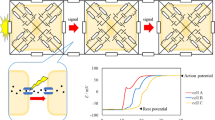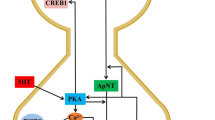Abstract
Quantal synaptic currents were recorded at nerve terminations on the opener muscle of crayfish using a macropatch-clamp electrode, and the release was elicited by depolarizing current pulses applied to the terminal through the same electrode. After 2 ms depolarization pulses at low temperature, release started with about 2 ms delay after the onset of depolarization, and the maximum rate of release occurred at about 4 ms delay. Large variations in Ca inflow during the pulses were concluded from the facilitation of test EPSCs. The time course of release proved to be remarkably invariant in spite of large changes in release. If a conditioning train of depolarization pulses preceded the test pulse, release due to the test pulse was facilitated up to 60-fold, but the shapes of distributions of quantal delays were practically not affected by this facilitation. Facilitation by the conditioning trains must have raised the [Ca]i level at the onset of the test pulse. The invariance of the time course of release with respect to the level of [Ca]i cannot be explained by theories in which [Ca]i alone controls the time course of release.
The time courses of reactions controlling release were explored by mathematical analysis and simulation. A reaction scheme in which the activation of “release sites” directly by depolarization had rate limiting control on the release reactions, in which rise of [Ca]i only was a promoting cofactor, and in which a cooperative reaction involving the complex of release sites and Cai, (SCai) was one of the final steps eliciting release, was able to predict the delayed onset of release and the substantial latency between the end of the depolarization pulse and the maximum of the rate of release. Reaction schemes in which the direct effect of depolarization on release occurred at one or more steps following the entry of Ca could be excluded generally by showing conflict with the experimental findings.
Similar content being viewed by others
References
Barrett EF, Stevens CF (1972) The kinetics of transmitter release at the frog neuromuscular junction. J Physiol (Lond) 227:691–708
Chad J, Eckert R, Ewald D (1984) Kinetics of Ca-dependent inactivation of calcium current in neurones of Aplysia californica. J Physiol (Lond) 347:279–300
Charlton MP, Smith SJ, Zucker RS (1982) Role of presynaptic calcium ions and channels in synaptic facilitation and depression at the squid giant synapse. J Physiol (Lond) 323:173–193
Dodge FA, Rahamimoff R (1967) Cooperative action of calcium ions in transmitter release at the neuromuscular junction. J Physiol (Lond) 193:419–432
Dudel J (1983a) Graded or all-or-nothing release of transmitter quanta by local depolarizations of nerve terminals on crayfish muscle? Pflügers Arch 398:155–164
Dudel J (1983b) Transmitter release triggered by a local depolarization in motor nerve terminals of the frog: role of calcium entry and of depolarization. Neurosci Lett 41:133–138
Dudel J (1984a) Control of quantal transmitter release at frog's motor nerve terminals. I. Dependence on amplitude and duration of depolarization. Pflügers Arch 402:225–234
Dudel J (1984b) Control of quantal transmitter release at frog's motor nerve terminals. II. Modulation by de- or hyperpolarizing pulses. Pflügers Arch 402:235–243
Dudel J, Parnas I, Parnas H (1982) Neurotransmitter release and its facilitation in crayfish. III. Amplitude of facilitation and inhibition of entry of calcium into the terminal by magnesium. Pflügers Arch 393:237–242
Dudel J, Parnas I, Parnas H (1983) Neurotransmitter release and its facilitation in crayfish muscle. VI. Release determined by both, intracellular calcium concentration and depolarization of the nerve terminal. Pflügers Arch 399:1–10
Dudel J, Parnas I, Cohen I, Franke CH (1984) Excitability and depolarization-release characteristics of excitatory nerve terminals in a tail muscle of spiny lobster. Pflügers Arch 401:293–296
Eckert R, Chad JE (1984) Inactivation of Ca channels. Prog Biophys Mol Biol 44:215–267
Hagiwara S, Takahashi K (1967) Surface density of calcium ions and calcium spikes in the Barnacle muscle fiber membrane. J Gen Physiol 50:583–601
Jenkinson DH (1957) The nature of antagonism between calcium and magnesium ions at the neuromuscular junction. J Physiol (Lond) 138:434–444
Johnson EW, Wernig A (1971) The binomial nature of transmitter release at the crayfish neuromuscular junction. J Physiol (Lond) 218:757–767
Katz B, Miledi R (1965) The effect of calcium on acetylcholine release from motor nerve terminals. Proc R Soc (London) B 161:496–503
Katz B, Miledi R (1967a) Tetrodotoxin and neuromuscular transmission. Proc R Soc (London) B 167:8–22
Katz B, Miledi R (1967b) The release of acetylcholine from nerve endings by graded electric pulses. Proc R Soc (Lond) B 167:23–38
Katz B, Miledi R (1968) The role of calcium in neuromuscular facilitation. J Physiol (Lond) 195:481–492
Llinás R, Nicholson C (1975) Calcium role in depolarization-secretion coupling: an aequorin study in squid giant synapse. Proc Natl Acad Sci USA 72:187–190
Llinás R, Steinberg IZ, Walton K (1981a) Presynaptic calcium currents in squid giant synapse. Biophys J 33:289–321
Llinás R, Steinberg IZ, Walton K (1981b) Relationship between presynaptic calcium current and postsynaptic potentiation in squid synapse. Biophys J 33:322–351
Miledi R, Parker I (1981) Calcium transients recorded with arsenazo III in the presynaptic terminal of the squid giant synapse. Proc R Soc (Lond) B 212:197–211
Parnas H, Dudel J, Parnas I (1982) Neurotransmitter release and its facilitation in crayfish. I. Saturation kinetics of release, and of entry and removal of calcium. Pflügers Arch 393:1–14
Parnas H, Dudel J, Parnas I (1982b) Neurotransmitter release and its facilitation in crayfish. IV. The effect of Mg2+ ions on the duration of facilitation. Pflügers Arch 395:1–5
Parnas H, Segel LA (1984) Exhaustion of calcium does not terminate evoked neurotransmitter release. J Theor Biol 107:345–365
Parnas I, Parnas H, Dudel J (1982a) Neurotransmitter release and its facilitation in crayfish. II. Duration of facilitation and removal processes of calcium from the terminal. Pflügers Arch 393:232–236
Parnas I, Parnas H, Dudel J (1982b) Neurotransmitter release and its facilitation in crayfish muscle. V. Basis for synapse differentiation of the fast and slow type in one axon. Pflügers Arch 395:261–270
Parnas I, Dudel J, Parnas H (1984) Depolarization dependence of the kinetics of phasic transmitter release at the crayfish neuromuscular junction. Neurosci Lett 50:157–162
Parnas I, Parnas H, Dudel J (1986) Neurotransmitter release and its facilitation in crayfish. VIII. Modulation of release by hyperpolarizing pulses. Pflügers Arch 406:131–137
Simon SM, Sugimori M, Llinás R (1984) Modelling of submembranaceous Ca concentration changes and their relation to rate of presynaptic transmitter release in the squid giant synapse. Biophys J 45:264A
Stockbridge N, Moore JW (1984) Dynamics of intracellular calcium and its possible relationship to phasic transmitter release and facilitation at the frog neuromuscular junction. J Neurosci 4:803–811
Zucker RS, Charlton MP, Smith SJ (1980) Presynaptic calcium currents and facilitated transmitter release in the giant synapse ofLoligo pelaei. Biol Bull 159:494
Zucker RS, Stockbridge N (1983) Presynaptic calcium diffusion and the time course of transmitter release and synaptic facilitation at the squid giant synapse. J Neurosci 3:1263–1269
Author information
Authors and Affiliations
Additional information
Supported by a grant of the Deutsche Forschungsgemeinschaft
Rights and permissions
About this article
Cite this article
Parnas, H., Dudel, J. & Parnas, I. Neurotransmitter release and its facilitation in crayfish. Pflugers Arch. 406, 121–130 (1986). https://doi.org/10.1007/BF00586672
Received:
Accepted:
Issue Date:
DOI: https://doi.org/10.1007/BF00586672




